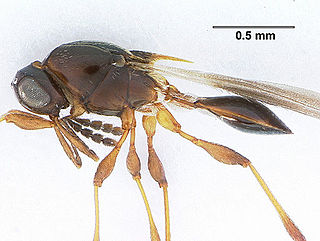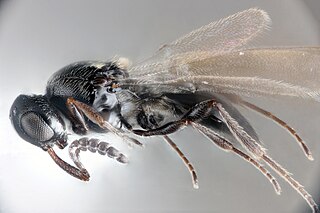
The Hymenopteran superfamily of parasitoid wasps, Platygastroidea, has often been treated as a lineage within the superfamily Proctotrupoidea, but most classifications since 1977 have recognized it as an independent group within the Proctotrupomorpha. It is presently has some 4000 described species. They are exclusively parasitic in nature.

The hymenopteran family Platygastridae is a large group of exclusively parasitoid wasps, mostly very small (1–2 mm), black, and shining, with geniculate (elbowed) antennae that have an eight-segmented flagellum. The wings sometimes lack venation, though they may have slight fringes of setae.

The hymenopteran family Scelionidae is a very large cosmopolitan group of exclusively parasitoid wasps, mostly small (0.5–10 mm), often black, often highly sculptured, with (typically) elbowed antennae that have a 9- or 10-segmented flagellum. It was once considered to be a subfamily of the Platygastridae, but has been revived in the most recent classification of Platygastroidea.

Platygaster is a genus of parasitoid wasps in the family Platygastridae. There are more than 560 described species in Platygaster.
Calliscelio is a parasitoid wasp genus which contains two species, C. elegans and C. teleogrylli.

Trissolcus japonicus, the samurai wasp, is a parasitoid wasp species in the family Scelionidae, native to east Asia but now found in Europe, North America, and Chile. It is chiefly known for parasitizing Halyomorpha halys. It deposits eggs into the eggs of the stink bug, and as the wasp larvae develop, they kill the stink bug eggs. A single adult wasp emerges from each stink bug egg.
Synopeas is a genus of parasitoid wasps in the family Platygastridae. There are about 400 described species in Synopeas.
Oethecoctonus is a genus of parasitoid wasps in the family Platygastridae. There are about six described species in Oethecoctonus.

Scelioninae is a subfamily of wasps in the family Scelionidae. It is a very large cosmopolitan group of exclusively parasitoid wasps, mostly small (0.5–10 mm), often black, often highly sculptured, usually with geniculate (elbowed) antennae that have a 9- or 10-segmented flagellum. It was formerly classified as a subfamily of the Platygastridae, but in 2021 the family Scelionidae was revived, containing the subfamilies Scelioninae, Teleasinae, and Telenominae.
Metaclisis is a genus of parasitoid wasps in the family Platygastridae. There are at least 30 described species in Metaclisis.

Trichacis is a genus of parasitoid wasps in the family Platygastridae. Members of this genus have a tuft of setae on the mesoscutellum and transverse striae or rugulae above the antennae. They are parasitoids of Cecidomyiidae, although the hosts of most species remain unknown.
A list of the species of Hymenoptera from New Zealand; which includes ants, bees, parasitoids, sawflies, and social wasps.

Idris is a genus of parasitic wasps in the family Platygastridae, containing about 160 described species. This genus is part of the tribe Baeini, which are egg parasitoids. Members of the genus Idris are mostly parasitoids of spider eggs, but at least one member of the genus uses stink bugs as hosts.
Rao is a genus of parasitoid wasps belonging to the family Platygastridae.
Sparasion is a genus of wasps belonging to the family Sparasionidae, within the superfamily Platygastridae. The genus has specimens widespread in Eurasia, Africa, and temperate North America.

Neuroscelionidae is a family of wasps in the superfamily Platygastroidea. It contains only one extant genus, Neuroscelio, with two other genera known from fossils. Members of Neuroscelio are known from Southeast Asia and Australia. Their hosts are unknown.

Sparasionidae is a family of wasps in the superfamily Platygastroidea. Known species are parasitoids of the eggs of orthopterans.

Ambositrinae is a subfamily of parasitoid wasps, within Diapriidae. The subfamily was first described by Canadian entomologist Lubomir Masner in 1961. Most species have a Gondwanan distribution, being found in Australia, New Guinea, New Zealand and South America.

Stephen Ernest Thorpe was an English-born entomologist in New Zealand. He contributed vast amounts of data and analysis in many contexts, particularly to iNaturalist. Thorpe was a member of the research group that described the beetle genus Neodoxa in 2003. In 2011, he helped with describing the New Zealand marsh beetle species Stenocyphon neozealandicus by recognising the species among unsorted insect specimens at Auckland War Memorial Museum while he was volunteering. Thorpe was murdered on 24 August 2024 during his daily walk to search for insects and plants. Thirteen species were named after Thorpe.
Zelostemma thorpei is a species of parasitoid wasp belonging to the family Platygastridae. First described by Peter Neerup Buhl in 2017, it is endemic to New Zealand.











